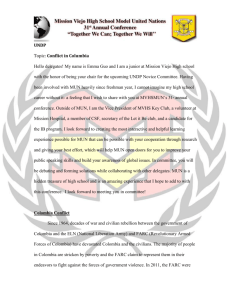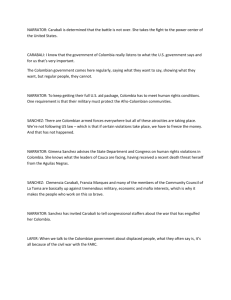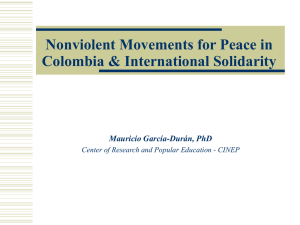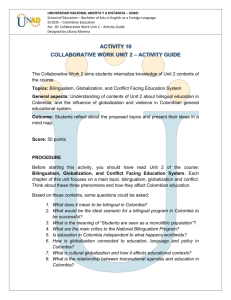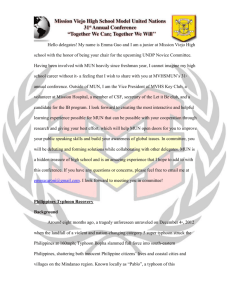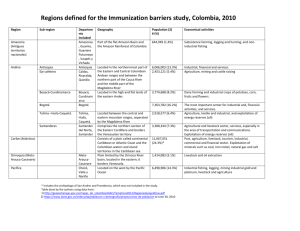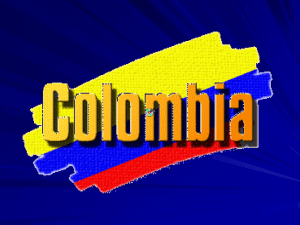The End of Civil Conflict in Colombia: The Military, Paramilitaries
advertisement
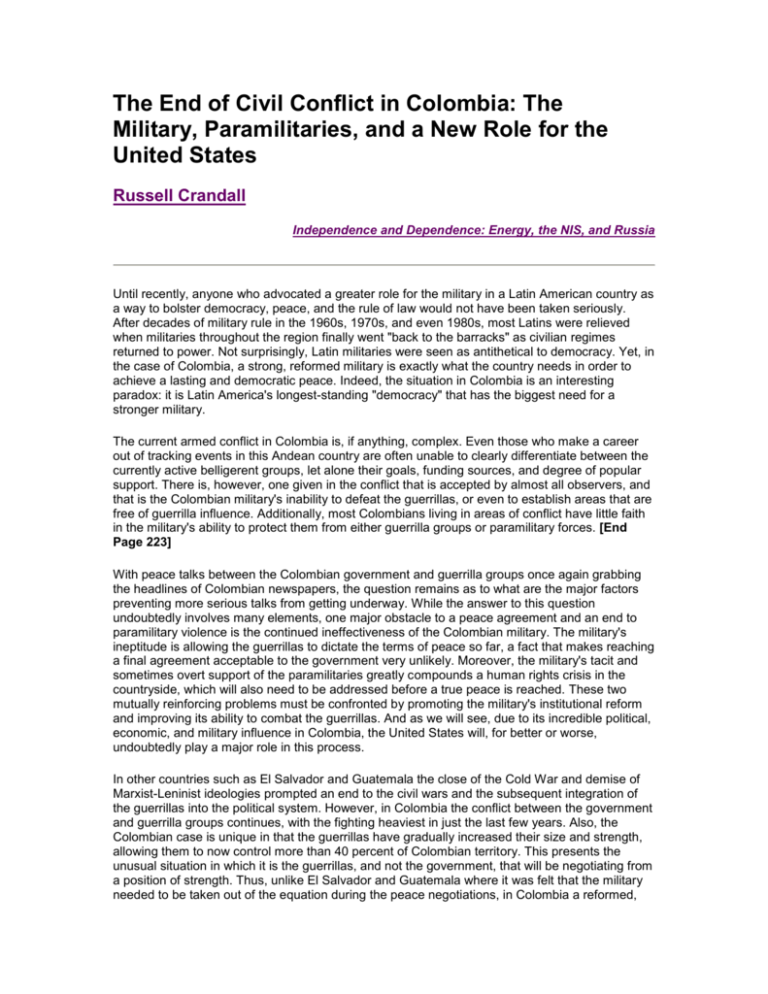
The End of Civil Conflict in Colombia: The Military, Paramilitaries, and a New Role for the United States Russell Crandall Independence and Dependence: Energy, the NIS, and Russia Until recently, anyone who advocated a greater role for the military in a Latin American country as a way to bolster democracy, peace, and the rule of law would not have been taken seriously. After decades of military rule in the 1960s, 1970s, and even 1980s, most Latins were relieved when militaries throughout the region finally went "back to the barracks" as civilian regimes returned to power. Not surprisingly, Latin militaries were seen as antithetical to democracy. Yet, in the case of Colombia, a strong, reformed military is exactly what the country needs in order to achieve a lasting and democratic peace. Indeed, the situation in Colombia is an interesting paradox: it is Latin America's longest-standing "democracy" that has the biggest need for a stronger military. The current armed conflict in Colombia is, if anything, complex. Even those who make a career out of tracking events in this Andean country are often unable to clearly differentiate between the currently active belligerent groups, let alone their goals, funding sources, and degree of popular support. There is, however, one given in the conflict that is accepted by almost all observers, and that is the Colombian military's inability to defeat the guerrillas, or even to establish areas that are free of guerrilla influence. Additionally, most Colombians living in areas of conflict have little faith in the military's ability to protect them from either guerrilla groups or paramilitary forces. [End Page 223] With peace talks between the Colombian government and guerrilla groups once again grabbing the headlines of Colombian newspapers, the question remains as to what are the major factors preventing more serious talks from getting underway. While the answer to this question undoubtedly involves many elements, one major obstacle to a peace agreement and an end to paramilitary violence is the continued ineffectiveness of the Colombian military. The military's ineptitude is allowing the guerrillas to dictate the terms of peace so far, a fact that makes reaching a final agreement acceptable to the government very unlikely. Moreover, the military's tacit and sometimes overt support of the paramilitaries greatly compounds a human rights crisis in the countryside, which will also need to be addressed before a true peace is reached. These two mutually reinforcing problems must be confronted by promoting the military's institutional reform and improving its ability to combat the guerrillas. And as we will see, due to its incredible political, economic, and military influence in Colombia, the United States will, for better or worse, undoubtedly play a major role in this process. In other countries such as El Salvador and Guatemala the close of the Cold War and demise of Marxist-Leninist ideologies prompted an end to the civil wars and the subsequent integration of the guerrillas into the political system. However, in Colombia the conflict between the government and guerrilla groups continues, with the fighting heaviest in just the last few years. Also, the Colombian case is unique in that the guerrillas have gradually increased their size and strength, allowing them to now control more than 40 percent of Colombian territory. This presents the unusual situation in which it is the guerrillas, and not the government, that will be negotiating from a position of strength. Thus, unlike El Salvador and Guatemala where it was felt that the military needed to be taken out of the equation during the peace negotiations, in Colombia a reformed, legitimate military that at least is able to achieve a strategic stalemate with the guerrillas will be a key component of the negotiations. For years the poorly equipped, ill-trained Colombian military has been forced to tacitly acknowledge guerrilla-controlled areas of the country, and various agreements have existed between the two groups to leave each other alone. This in part explains the long period (from the late 1940s through today) that the insurgency has endured, with no apparent end in sight. Recent years have seen an increase in the presence and brutality of privately funded paramilitary groups that has brought a whole set of new and pernicious dynamics [End Page 224] to the war. The conflict in Colombia is no longer a low-intensity struggle between the military and guerrilla groups. Now, the well-funded, ruthless paramilitaries have stepped in to confront the guerrillas. To understand the present scenario and why a lasting solution requires the reform of the military, it is first necessary to review the roots of the guerrilla insurgency and paramilitary groups. Background The beginnings of the guerrilla insurgency in Colombia trace back roughly to the assassination of populist Liberal Party political leader Jorge Elécier Gaitán in 1948. For many Colombians, Gaitán was seen as a progressive, modernizing president who was committed to ending Colombian society's gross inequalities and injustices. Thus, his death sparked outrage among the Liberals who vented their anger on the Conservatives. The Conservatives responded in kind and thus began the period of unprecedented violence known as La Violencia that ended after some 200,000 Colombians had been killed. The reasons for La Violencia are shocking and manifold: the traditional hatred between the Liberals and Conservatives; landowners' justification of violence as a means to increase their land holdings; and right-wing propaganda that an international communist conspiracy was at work in Colombia. It was within this context of anarchy and hatred that Marxist guerrilla groups sprouted up throughout the countryside. The era of La Violencia continued for around ten years until the Liberal and Conservative Parties joined to form the National Front. As elites within both parties realized that such violence was not in their interests, they decided to enter into a power-sharing agreement whereby they would alternate the presidency every four years, and equally divide all of the important political appointments. While this agreement was far from democratic, it curbed the violence that ravaged the Colombian countryside. This agreement lasted-- albeit with some intermittent military intervention--until 1978, when the presidency once again became more freely contested. But while violence in the countryside dropped precipitously during the period of the National Front, guerrilla groups continued their struggle, which as of today shows few signs of letting up. The Formation of the Guerrillas The Colombian Armed Revolutionary Forces (FARC) are Colombia's oldest leftist guerrilla group. They were formed as an [End Page 225] outgrowth of the self-defense forces that were established during the time of La Violencia in rural communist stronghold areas, putatively to protect local residents from retribution by anticommunist forces. While not a direct arm of the Colombian Communist Party, the FARC shared many objectives with the party. While the FARC began in the upper Magdalena region of Colombia, over the last several decades they have formed "fronts" (including anywhere from a few to several hundred people) throughout Colombia, gaining most influence wherever the state has traditionally been weak or non-existent. It is estimated that the FARC presently have anywhere from 12,000 to 15,000 members, scattered across over one hundred fronts. With the end of international communism, it is hard to get a feel for just exactly what the FARC--or any of the other leftist guerrilla groups-stand for these days. While their rhetoric supports the ideals of equality, justice, and rural land reform, many believe that the FARC are more interested in reaping large profits from drug traffickers and using it to establish political rule in rural regions. Many Colombians suspect that it is probably a little of both. 1 The National Liberation Army (ELN) is the other major guerrilla group still active in Colombia today. Unlike the FARC with their Moscow-oriented origins, the ELN began more as a traditional Latin American revolutionary group, along the lines of Fidel Castro's movement in Cuba in the 1950s (which strongly influenced the ELN) or the Sandinistas in Nicaragua in the 1970s and 1980s. Instead of adhering to a policy of assisting the rural farmer in a proletarian struggle, the ELN tapped into the discontent of disaffected middle class youth for the majority of its support. These guerrilla groups were probably correct to state that it was virtually impossible to bring about major political change based on orthodox, non-violent methods. To the guerrillas, peaceful protest was useless; the National Front was a sham intended to keep the oligarchy in power. Yet, while the guerrillas probably never would have been able to seize power even if these two groups had been fully united, the fractured nature of the armed left--best exemplified by the aforementioned ideological differences between the FARC and ELN--guaranteed that they would never take control. For the next several decades after La Violencia, the guerrilla groups continued to operate in the countryside, often controlling large, isolated "zones of influence" where the military never dared to enter. Yet, because these groups were never very active in the cities, most Colombians were not affected by their activities. [End Page 226] Attempts at Peace While hopes that President Andrés Pastrana might be able to negotiate a sort of cease-fire or peace agreement with some of the guerrilla groups is currently renewing optimism, it is important to note that a major peace initiative was conducted in the early and mid-1980s with mixed results. During the presidency of Belisario Betancur (1982 to 1986), a peace accord resulted in, among other things, a military truce, a return of hostages, a process of dialogue, and the guerrillas' commitment to lay down their arms. While the FARC and ELN participated in these negotiations, many of the factional fronts in each of these groups refused to accept the terms of the accord. Nevertheless, many of the guerrillas who did sign the peace agreement subsequently formed the Patriotic Union (UP), a political party with a large number of FARC members comprising its membership. Yet, in something that has great relevance to today's peace negotiations, in the years following the creation of the UP, over one thousand of its members were assassinated, including its presidential candidate in 1986 and its presidential nominee in 1990. In light of these attacks, it is therefore no surprise that today many members of the FARC and ELN are suspicious of the government's ability to ensure their safety should they agree to a peace accord with the Pastrana administration. The Roots of the Paramilitaries As the FARC and other guerrilla groups gained strength in rural Colombia, they began to demand "revolutionary taxes" from landowners who lived in these areas. This continued more or less unabated from the 1960s to the early 1980s, but in some cases landowners or peasant organizations created self-defense groups in an attempt to end the influence of the guerrillas. This brand of paramilitary group, known as convivir (roughly translated as "living together"), was institutionalized by the Colombian state in the early 1980s. They received official government sanction and oftentimes military assistance. The convivirs were ostensibly disbanded in 1989 after many were accused of unjustified violence, but many are still around today. While the convivirs make up one type of paramilitary group, the last decade has seen the rise of other types of paramilitary groups that are much more powerful and influential than the convivirs. As drug trafficking--especially cocaine--brought incredible profits to Colombia in the 1980s, many involved in the drug business began buying up land in rural areas. In fact, legitimate [End Page 227] landowners were often more than happy to sell their land after so many years of harassment by the guerrillas. Since these new "narco-landowners" had the money to buy sophisticated weaponry, they were often reluctant to continue paying revolutionary taxes to the guerrillas. Consequently, wars erupted when landowners began recruiting, equipping, and training their own local armies (paramilitaries), and using them to rid the areas of guerrilla influence. The landowners have also used their paramilitary groups for economic ends, expelling communities from areas where landowners would like to graze cattle or expand crop plantation, often disrupting threatened rural communities. It is estimated that over the past several years, close to one million Colombians have been displaced internally, with many of the more recent cases being directly linked to paramilitary activities. These private paramilitary groups often have tacit or overt support from the Colombian military, since the latter prefers to have the paramilitaries do its dirty work and thus take the blame for committing human rights abuses. The result of the rise of this type of paramilitary group has meant that many previously guerrilla-ruled areas have become safe for ranching, but remain deadly for anyone suspected of having even remote connections or sympathies with the guerrillas. Current Situation Paramilitary-Guerrilla-Military Dynamics Over the past several decades, the word paramilitary has been used in Colombia to describe groups ranging from citizen militias formed to protect their towns against guerrilla intrusions, to highly armed quasi-armies funded by wealthy landowners who seek to expand their land holdings and economic influence. It is this second brand of paramilitary group that has filled the vacuum left by an ineffective military and is quickly gaining tremendous influence throughout rural Colombia, often by using brutal tactics. Indeed, paramilitary groups are presumed responsible for at least 75 percent of all conflict-related deaths in Colombia. In recent years, the paramilitaries have aggressively increased their presence in the armed conflict, seeking to eliminate the guerrillas' hegemony by terrorizing their social base within the civilian population. No longer content to sit around while the guerrillas roam with impunity and the military hides behind sandbags, the paramilitaries have enacted a brutal scorched-earth campaign of killing anyone who is even remotely linked--or [End Page 228] purported to be linked--to guerrilla groups. The idea is that if the civilian population refuses to have any contact with the guerrillas for fear of retribution by the paramilitaries, then the guerrillas will eventually lose support and fade away. Catholic Church workers and human rights activists, who used to be seen as unbiased mediators between the military and guerrillas, have become targets of the paramilitaries, who view them as apologists for the guerrillas. 2 In February 1998, for example, in the southern state of Putumayo, paramilitary groups entered a town and listed the names of priests and other activists to signal that they had been marked for death. One major consequence of the paramilitaries' methods has been to further weaken an already extremely fragile civil society in the Colombian countryside. These paramilitary groups often operate with the support of the Colombian military. Residents of the oil-producing city of Barrancabermeja complain bitterly that the military generally does not hinder the actions of the paramilitary groups, and point to the fact that the paramilitaries are rarely stopped at military checkpoints. 3 Many believe that without the support of the Colombian military, the paramilitaries would not be nearly so effective. Yet, in recent years it looks as though some of the paramilitary groups are gaining a life of their own, and their reliance on military support might not be as important as it was in previous years. One of the most notorious paramilitary groups, led by landowner Carlos Castaño who has his headquarters in the northwest of Colombia, has acquired sophisticated weaponry, making it increasingly less reliant on the military. Many suspect that drug money funds Castaño's group. 4 His fighting force has been effective at confronting the guerrillas or, better said, confronting supposed civilian supporters of the guerrillas. The rise of landowners such as Castaño proves that the paramilitaries do not always work on behalf of the military. Increasingly, the paramilitaries have their own agenda and will use military support when it is to their advantage; when it is not, they will continue fighting alone. What Can Be Done? Most Colombians are tired of this senseless violence. One leading magazine, Cambio 16, ran "So What Are They All Fighting About?" on its cover in reference to interviews conducted with the paramilitaries and guerrillas revealing that both groups had similarly stated goals. Most Colombians firmly believe that a negotiated solution is the best--and probably only--way to resolve the conflict. [End Page 229] Underlying this view is a general consensus that not one of the belligerent groups will ever be able to gain a military victory. The recent preliminary peace talks that President Andrés Pastrana conducted with the FARC are an encouraging sign, although peace settlements have been reached before and many of them ended up in tatters. Not surprisingly, the FARC have followed up on their "peace overtures" by attacking military positions in the northern state of Urabá and near the Brazilian border, killing dozens of soldiers and taking scores more hostage. Thus we have a complex situation whereby, despite the harassment and defeats inflicted by the paramilitaries, the guerrillas are expanding their overall influence without eliciting any substantive response from the military. One Colombian observer has put the increased strength of the guerrillas into perspective by stating how years ago the guerrillas would flee after blowing up an oil pipeline, but now they stick around afterwards to drink coffee. 5 Ironically, the frightening escalation of paramilitary and guerrilla violence might force the beginning of legitimate negotiations sooner rather than later. As manifested by the recent increase in raids, the FARC and ELN have been able to make a mockery of the government's counter-insurgency efforts. In the last three years they have killed over three hundred soldiers and taken another 243 hostage. 6 Yet, only with the paramilitaries' recent successes at expelling the guerrillas from many areas (the paramilitaries call this practice limpieza, or "cleaning"), have the guerrillas been put onto any type of defensive. This dramatic turnabout might encourage the guerrillas to seriously consider a negotiated settlement. Yet this is far from certain, since the guerrillas' overall influence has increased. This scenario is complicated by the fact that the guerrillas adamantly oppose any legitimized political role for the paramilitaries. The FARC and ELN see themselves as the rightful adversaries of the government and thus any "third party" only takes away from their ability to gain concessions. Still, the paramilitaries' continued success against the guerrillas could very well win them a seat at any eventual negotiating table whether the guerrillas like it or not. The Need to Strengthen the Military in Order to Establish the Rule of Law Regardless of which groups participate in the peace talks, any negotiated settlement will only come about once the rule of law is firmly established in the areas of conflict. It is hard to see how the [End Page 230] government can negotiate effectively when control of so much of the country is out of its hands. A majority of Colombians, regardless of their political orientation, believe that the Colombian state should defend itself better against the guerrillas. And while there are other extremely important aspects of establishing the rule of law (for example, effective judiciary and electoral systems, land reform, and education), many Colombians are convinced that the essential component is strengthening the military to make it an effective fighting force, all the while cleaning up its human rights record and cutting its support for the paramilitaries. These reforms should focus on improving the military's institutional capacity (its professionalism and human rights record) and its relations with the rural population, as well as forcing it to end its pernicious relationship with the paramilitaries. Obviously, any strengthening of the Colombian military must be done with the utmost care as it is not presently a respectable institution. Any ill- conceived increase in its firepower would just exacerbate a bad situation. Clearly, the military must not be allowed so much influence that Colombia's civilian institutions are suddenly at the mercy of the men in uniform. Lasting reform of the Colombian military will take time. It remains an inept fighting force; it tacitly supports brutal paramilitary groups that are wreaking havoc on civilian populations throughout the country; and it is conducting a systematic campaign to harass, intimidate, threaten, and sometimes kill human rights workers who are committed to finding a peaceful solution to this tragic conflict. Thus, the Colombian people need to put tremendous pressure on their elected officials, demanding that the military be cleaned up. This will not be easy, but examples of military reform in other countries such as El Salvador and Argentina, while far from perfect, show that progress can be made. Fortunately, the Colombian military has recently made some steps--albeit preliminary--toward institutional reform. In addition to changing its combat strategies and tactics, the military has affirmed its commitment to respecting human rights. General Fernando Tapias, the newly appointed commander of the Colombian military forces, recently stated that: "We hope that the actions of the military forces will be effective but with absolute adherence to International Humanitarian Law." 7 Moreover, in September 1998, the Colombian newspaper El Tiempo sponsored a conference on reform of the Colombian military that included members of civil society, former guerrillas, and military personnel from El Salvador who negotiated their country's peace settlement, and General Tapias. Not only was the military's [End Page 231] participation an unexpected change of strategy, but General Tapias admitted that the present conduct of the military is unacceptable and that it needs to establish a new relationship with civil society so as to differentiate it from the other "illegitimate" armed actors such as the paramilitaries and guerrillas. 8 While these are encouraging signs, the Colombian military has much to do before it will be seen as a legitimate fighting force in the eyes of the thousands of Colombians who live in the combat zones. The United States could do much to push the military down this path but, as we will see, the single-minded pursuit of counternarcotics efforts prevents it from effectively and positively influencing the Colombian military. The Role of the United States The strong political, economic, and military influence that the United States has in Colombia means that Washington will undoubtedly play some sort of role in the conflict. The military's reliance on influential U.S. funding shows that the U.S. government has the means to pressure the military along a reformist path. However, in their obsession with counternarcotics efforts, Washington policymakers have overlooked this promising option time and again. It has been well documented that some of the equipment and training already provided by the United States has gone to military brigades that were implicated in human rights abuses. While U.S. officials--especially in Congress--have done much to prevent assistance from going to these brigades, this is nevertheless a poignant example of how U.S. funding, when not well administered, can actually do more harm than good. With the state of the Colombian military as it is today, the United States needs to do much more than just try to differentiate between "good" and "bad" military units. Believing that this type of passive pressure will be enough to foster the reform of the Colombian military seems overly hopeful at best and naïve at worst, especially when military support of the paramilitaries is involved. 9 Even the U.S. State Department in its annual report on human rights (written by personnel in the U.S. embassy in Bogotá) states that in Colombia "killings by paramilitary groups increased significantly, many times with the complicity of individual soldiers or military units, or with the knowledge and tacit approval of senior military officials." 10 [End Page 232] U.S. Counternarcotics Funding to Colombia Year 1997 1998 1999 (est.) U.S. $ Millions 136 140 280 Source: Department of State, Bureau of International Narcotics and Law Enforcement (INL), 1998 It is obviously not the intention of anyone in Congress or a U.S. government agency to exacerbate the human rights problem in Colombia. The U.S. government should thus take much greater precaution to see that it is influencing the situation in a positive manner. Moreover, as is often the case, there will be strong pressure from the Pentagon, CIA, and other government agencies to increase support to the Colombian military. While this might improve its fighting ability, funding alone will do nothing to lessen the military's human rights abuses or links to the paramilitaries. From the United States' perspective, Colombia is not Vietnam; but if the United States is not careful with its assistance to Colombia, it could quickly become a South American version of this quagmire. With the Colombian military still a long way from achieving substantive reform, the United States should consider focusing less on counternarcotics assistance and more on pressuring the Colombian government to clean up the military. For years the United States has put tremendous pressure on the Colombian government and military with regard to the anti-narcotics issue, including decertifying Colombia during the annual review of counternarcotics efforts. Yet, instead of certifying the Colombians solely on their drug efforts, U.S. policy would be more effective if it conducted a strict review of the military's progress in institutional reform, including its human rights record and its ability to put a lid on paramilitary activities. To date, the United States equates reform of the military with its improved ability to conduct counternarcotics operations; moreover, intense inter-agency competition for drug interdiction budget allocations appears to have eclipsed many of the original U.S. policy goals such as peace and civil society building. The United States' "litmus test" of the Colombian military's conduct is extremely narrow because, since the domestic drug use problem is such an important issue in the United States, [End Page 233] Washington tends to formulate policy toward Colombia according to this domestic policy concern, rather than foreign policy considerations. The United States might better help lessen tensions and violence in Colombia if it demanded a well-documented improvement in the latter's military performance rather than focusing on whether or not it follows U.S.-mandated counternarcotics efforts. Statements from government officials of various U.S. agencies suggest that the United States is not committed to pursuing an effective strategy that would help alleviate the number of human rights abuses in Colombia. 11 Since the U.S. Congress has passed legislation that prohibits any military assistance to divisions of the Colombian military suspected of human rights abuses, the U.S. military has an incentive to show that the Colombian military is not directly involved in human rights violations. Rarely does one hear U.S. government officials talk about the tacit support that the Colombian military gives to the paramilitaries. A high-level U.S. military officer recently stated that he is pleased with the Colombian military's human rights record and is confident that the military does not provide support for the paramilitaries' operations. This officer also said that his view is based upon assurances given to him by General Bonnet, the head of the Colombian armed forces until he was recently dismissed by President Pastrana, who himself was accused of not doing enough to clamp down on military abuses. This position contradicts not only what is widely believed by most Colombians, but it also runs against the aforementioned U.S. State Department human rights report. The United States' prioritization of the drug war now means that for many in the U.S. government, arming segments within the Colombian armed forces has become a top priority. The cynical view would be that the United States is only interested in the human rights abuses committed directly by the military, since those are the only ones that would potentially prevent U.S. military aid from continuing. Drugs as the New Evil Empire During the Cold War, U.S. policy toward Latin America was above all to oppose communist infiltration of the region, whether real or perceived. Even though it meant overthrowing democratic regimes or allying with unsavory authoritarian regimes, the United States had a clear, predictable framework within which to conduct its policies. Now that era has ended and the United States is struggling to come up with a new raison d'être in the region. Increasingly, it looks as [End Page 234] though drug lords are replacing communists as U.S. enemy number one in Latin America, and Colombia is ground zero in this new struggle. A high-ranking State Department official recently stated that "drugs are our first and foremost priority" in Colombia. 12 To achieve this end, the United States places heavy emphasis on what many (including most Colombians) feel are dubious counternarcotics efforts such as the fumigation of coca plants. This skepticism is increased by the fact that, while in 1997 U.S.sponsored fumigation eradicated thousands of hectares of coca plants, total coca production actually rose in that year. This growth in coca crops has not, however, deterred U.S. officials from stating that U.S. policy will be to fumigate even more hectares in the coming years. Even laying aside the debate over the ability of anti-narcotics efforts to stop the flow of drugs into the United States, these interdiction efforts, just like the paramilitaries' new brutality, are obviously damaging the already disrupted societies in these regions. In fact, farmers who have seen their livelihoods destroyed by fumigation or other counternarcotics efforts often end up becoming willing recruits for both the guerrillas and the paramilitaries. U.S. officials have finally begun to admit the destabilizing effects of initiatives such as fumigation and have belatedly authorized around $4 million for alternative crop programs and internal civilian displacement programs. However, compared to the close to $280 million that the United States will now send to Colombia for orthodox counternarcotics efforts, this sum can at best be considered a drop in the bucket. 13 In short, the U.S. counternarcotics strategy is circular: arm the Colombian military to fight the war on drugs, while the way that war is fought destabilizes the region, thereby requiring more funding of the Colombian military. Furthermore, U.S. officials claim that they are combating drug traffickers and guerrillas who are stronger and more sophisticated than ever due to profits from the drug trade; but these same officials rarely admit that it is the American cocaine and heroin habit that provides the millions of dollars that allow Colombian drug traffickers and guerrillas to purchase such weapons. Conclusion Colombia's relatively strong tradition of electoral democracy is clearly inadequate to deal with the violent reality that characterizes many of the country's regions. Finding an equitable and lasting peace agreement, as with everything in Colombia, will be an arduous [End Page 235] process. I have argued that one integral component of any permanent solution must be the establishment of a rule of law. Beyond ballot boxes, the Colombian government needs to offer its citizens protection from the belligerent groups now active. This path will invariably require that the Colombian military transform itself into an effective and respected fighting force. It will have to shed its tradition of abuse, corruption, and ineptitude, and pursue a reform path along the lines of militaries in Brazil, Argentina, or even Mexico. The United States, with its tremendous influence and resources, no doubt has the means to steer the military down this reformist path. But, instead, Washington equates the military's "reform" with its increased capacity to carry out counternarcotics operations. And a continued policy of pressuring the Colombian military to increase its destabilizing counternarcotics efforts might produce the ironic result of promoting not reform of the military, but rather its further deterioration. Moreover, the United States has already stated emphatically that any eventual peace agreement in Colombia cannot include autonomous zones for the guerrillas where they might be able to continue to produce and traffic drugs. Sadly, this example shows that, no matter how much the United States rhetorically supports the idea of peace in Colombia, it actually only supports a peace that fits nicely within U.S. counternarcotics strategy. Since the war on drugs seems to be a losing battle, it may be a long while before any peace agreement is reached that is acceptable to Washington. Only when the United States removes its "counternarcotics lenses" (just as it wore "anticommunist lenses" during the Cold War) will it be able to see that the conflict in Colombia is much more complicated than just cocaine and heroin, and that such difficult problems need equally complex and nuanced solutions. To be sure, calls for the reform of the Colombian military must come from within Colombian society, and ultimately it will be the Colombian people who will be to blame if such a call is not made. But the United States should and could help the Colombians tackle this daunting task. So far, however, U.S. policy in Colombia looks set to remain about drugs, drugs, and more drugs. Russell Crandall is a Ph.D. candidate in Latin American Studies at the Paul H. Nitze School of Advanced International Studies at the Johns Hopkins University-SAIS. Notes 1. The author conducted interviews with Colombians who deal with the issues of violence, human rights, military reform, and guerrilla movements at various times during the period from August 1997 to March 1998. Interviews were conducted in the cities and provinces of Barrancabermeja, Cali, Tumaco, Antioquia (Medellín, Santa Barbara, Santafé de Antioquia), Boyacá, Pasto, Ipiales, and Popayán. This paper does not mention the names of any of the interviewees for reasons of security. 2. The author first put forth these views in Russell Crandall, "Colombia Needs a Stronger Military," Wall Street Journal, June 12, 1998, p. A11. 3. Interviews conducted with a local human rights team in the city of Barrancabermeja, October 1997 and February 1998. 4. An interview with Carlos Castaño was conducted by Maria Cristina Caballero and published in "Esta Guerra no da mas," Cambio 16 (Bogotá, Colombia) December 15, 1997. 5. Diana Jean Schemo, "Risking Life, Limb, and Capital, U.S. CompaniesOperate in Colombia but Very Quietly," New York Times, November 6, 1998, p. B1. 6. "Cambio de Frente en la guerra," El Tiempo (Bogotá, Colombia) August 25, 1998. 7. Ibid. (Author's translation.) 8. "Si La Paz Fracasa, No Sera por FF.AA," El Tiempo, September 23, 1998, p. 6A. 9. The U.S. agencies that provide assistance to the Colombian military have often stated that they only deal with reputable military units and put pressure on those believed to be involved in human rights abuses. See Tod Robberson, "Colombian Army Faces Overhaul," Dallas Morning News, August 14, 1998. 10. United States Department of State, Annual Report on Human Rights 1997. 11. Honoring requests that statements not be attributed prevents the author from disclosing the names of the officials who made these comments. 12. Ibid. 13. Department of State Bureau of International Narcotics and Law Enforcement (INL), 1998.
